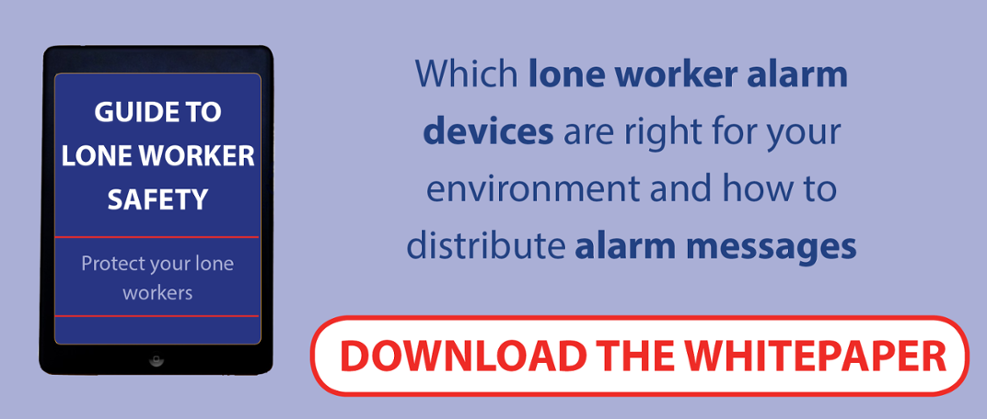
Are all your lone workers or employees safe? Unfortunately, a big percentage of employers have not installed practical lone worker safety measures to protect their staff working alone. Disappointingly, only 6% of lone workers are protected using lone worker alarm devices. Considering that there are an estimated 6.8 million lone workers in the UK, that there are millions of people in the UK that go to work every day unprotected.
As a manager, you should consider all possible dangerous events that may befall your workers while on site and take the wise step of installing a lone worker alarm solution.
Who is a lone worker?
A lone worker is anyone who regularly works alone, without contact or close supervision from another employee. The fact that there is no one else present puts lone workers at more risk than other employees who work alongside other colleagues in the workplace.
If this sounds familiar, then consider this: what happens if a lone worker suffers an accident or incident? And what systems are in place to alert colleagues and escalate a response? If the answer is ‘none’, how will anyone know that an emergency situation is unfolding and respond to it quickly and appropriately?
In this article, we explore why lone worker alarm systems are important and how they work, in order to help you be part of that 6% of employees who are protecting their lone workers adequately.
Why is it necessary for you to have lone worker alarm systems?
Examples of risky events that lone workers can suffer include:
- Heart attacks
- Strokes
- Slips
- Trips and falls
- Unconsciousness
- Equipment-caused accidents
- Abuse either verbal or physical from other people
All of the above can become fatal, especially if the lone worker has no means to alert others and receive help promptly. In fact, even receiving helps minutes before can sometimes make a difference between life or death, and therefore, having the right alarm system in place becomes even more important.
There is more risk for lone workers in the manufacturing industry than anywhere else. According to the HSE, 10% of all work-related deaths in the UK that took place between 2013 and 2014 were in the manufacturing industry.
UK employers are fully aware of their responsibilities to protect the health and safety of all lone workers. Whilst there is currently no specific legislation that relates to lone working, the 2007 introduction of the Corporate Manslaughter Act has focused management attention beyond the basic duty of care.
For business owners, the maximum penalty for an avoidable fatality is imprisonment, whilst unlimited fines are equally impactful. Moreover, the human and reputational implications are incalculable.
In addition to providing a means of calling for help, lone worker alarm systems help management to prevent future accidents. After an alarm has been made, it is important that the system has a facility to record all the details including the cause and response time.
By ensuring that the alarms log information such as date, time and location, you are able to have a credible audit trail that can be used to identify how quickly staff responded and if possible, where improvements can be made.
Get the right alarm system
There are many types of alarm systems that your company can use to safeguard employees, but it’s important that you choose the right one for your environment and situation. Here are some elements all alarm systems should include:
- The type of alarm system that your lone workers use should be easy to operate. The design should be simple or familiar for your employees to be able to call for help immediately should something happen.
- The device should also be capable of raising automatic alarms, through a man-down function that gets triggered if the user is rendered unconscious.
- It should help you locate where the incident took place so that you know where to send help. GPS coordinates can help pinpoint someone outdoors, whereas beacons are more appropriate for indoors where GPS does not work.
- It should have pre-alarms to activate warnings to the user in case it is a false alarm.
- Panic alarms to precipitate an alert when an accident occurs
- Devices that are capable of two-way speech also help to speed up response times and better protect those that have raised an alarm.
- The alarm solution should also be capable of alerting several respondents. It is practical to have a hierarchy of responders, just in case the first or second responder is absent or out of reach.
Different types of lone worker alarm devices
There are lots of different platforms that can be used for lone working solutions. These include:
- Digital Mobile Radio
- Private Mobile Networks
- VoWifi
- IP DECT Systems
Depending on the environment your lone workers operate in, you might need to consider intrinsically safe (ATEX) devices.
Generally, also mobile phone apps and devices can make a significant difference in lone worker safety conditions. Some lone apps impressively connect to a 24-hour alarm responding centre. Staff assigned to lone worker disaster management and other workers can be alerted via messages on their phones and PC.
Remember, the device that triggers your alarm should be linked to a practical response system. The lives of your employee's matter, keep them safe.





